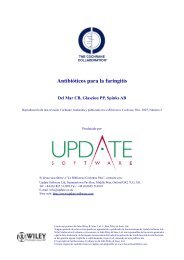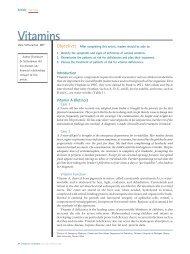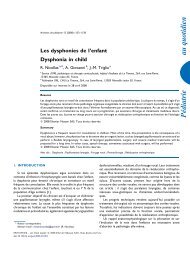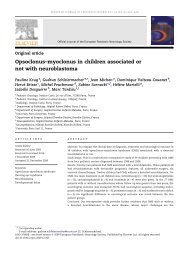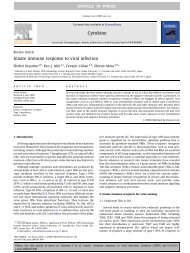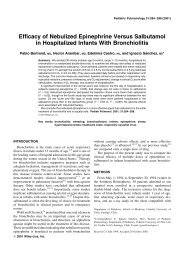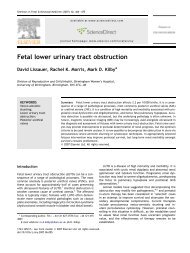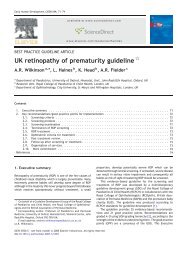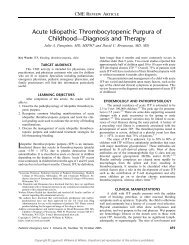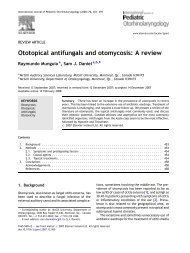Mini Review - sepeap
Mini Review - sepeap
Mini Review - sepeap
You also want an ePaper? Increase the reach of your titles
YUMPU automatically turns print PDFs into web optimized ePapers that Google loves.
354 Nader: Adrenarche And Polycystic Ovary Syndrome<br />
serum insulin, exaggerated insulin responses to glucose,<br />
low glucose to insulin ratios, and occasionally<br />
impaired fasting glucose or impaired glucose tolerance.<br />
Biochemical features may also include dyslipidemia,<br />
with high triglycerides and low HDL, and<br />
abnormal adipocytokine profiles, with excess markers<br />
of inflammation. 2 While the clinical and/or biochemical<br />
features of insulin resistance are very commonly<br />
observed, not all patients with PCOS are obese or<br />
significantly resistant to insulin. 3<br />
For the most part the patients pose little diagnostic<br />
challenge; there is, however, some variability in the<br />
clinical, pathologic and biochemical findings and it<br />
has proven hard to actually define the syndrome.<br />
The 1990 National Institutes of Health consensus criteria<br />
required oligo-ovulation and androgen excess. A<br />
subsequent consensus conference, held in Rotterdam<br />
in 2003, defined the syndrome as two of the following<br />
three features: oligo-ovulation, clinical or biochemical<br />
evidence of androgen excess and multicystic ovaries. 9<br />
It also required exclusion of late-onset congenital adrenal<br />
hyperplasia, Cushing’s syndrome, other causes<br />
of androgen excess and hyperprolactinemia. Since<br />
its publication, there have been conflicts of opinion regarding<br />
this definition: some have supported it<br />
while others believe that hyperandrogenism should<br />
be an integral part of the definition of this syndrome.<br />
10 These criteria and viewpoints are summarized<br />
by Azziz et al, 11 who presented a position<br />
statement from the Androgen Excess Society, stating<br />
the relevance and importance of hyperandrogenism<br />
in the syndrome.<br />
We present, both a review and a viewpoint, a broader<br />
and developmental view of PCOS is presented, one<br />
encompassing multiple possible derangements. The<br />
processes leading to reproductive competence are<br />
briefly reviewed and two hypotheses are presented.<br />
The first relates to adrenarche and proposes a role<br />
for this developmental process in the attainment of reproductive<br />
competence. The second concerns PCOS<br />
and suggests that this syndrome is a maladaptation<br />
of the events that lead to reproductive competence<br />
in women.<br />
Reproductive Competence<br />
During fetal life, differentiation of the gonads into<br />
ovaries and testes is directed by the sex chromosome<br />
complement of the fetus and the hypothalamic-pituitary-gonadal<br />
(H-P-G) axis becomes functional in utero.<br />
12 After the neonatal period, the H-P-G axis is<br />
suppressed and remains so until the onset of gonadarche,<br />
which is manifest as pulsatile release of<br />
gonadotropin secretion, initially nocturnal. The precise<br />
mechanisms leading to disinhibition of gonadotropin<br />
releasing hormone (GnRH) production, and<br />
subsequent gonadotropin secretion, remain unknown<br />
but include removal of central inhibition, by gammaaminobutyric<br />
acid and possibly other neurotransmitters,<br />
12 and as puberty advances, a reduction in sex<br />
steroid inhibition of GnRH, 13,14 as will be discussed<br />
in a separate section. Release of GnRH allows secretion<br />
of the gonadotropins, LH and FSH, leading to<br />
ovarian secretion of testosterone and estradiol. Menarche<br />
heralds estrogenization of the endometrium sufficient<br />
to lead to withdrawal bleeding. Following<br />
menarche, ovulatory cycles are not immediately<br />
established. A longitudinal study showed that within<br />
one and three years of menarche, 10 or more cycles<br />
per 12 months occur in 65% and 90% of adolescents<br />
respectively. 15 These percentages may overestimate<br />
ovulatory cycles, because progesterone concentrations<br />
were not determined in the study.<br />
The GnRH pulse generator appears to have an<br />
intrinsic maximum firing frequency of one pulse per<br />
hour after puberty. 16 The frequency of these pulses<br />
determines which gonadotropin is preferentially<br />
synthesized, rapid pulses favoring LH and slower<br />
favoring FSH. 17 During each ovulatory menstrual<br />
cycle, follicular growth and ovarian steroidogenesis<br />
are stimulated by LH and FSH: while a small amount<br />
of LH can lead to sufficient androgen secretion (precursors<br />
of estradiol), a finite, threshold concentration<br />
of FSH is required for aromatization of androgens<br />
(to estradiol) and growth of a mature Graafian follicle.<br />
In the late follicular phase, sustained estradiol production,<br />
through positive feedback, leads to massive pituitary<br />
LH release, that is, to the mid-cycle LH<br />
surge. 1e20 The surge is followed by rupture of the<br />
follicle and formation of the corpus luteum, which<br />
produces progesterone. Progesterone not only prepares<br />
the uterus for pregnancy, but slows the GnRH<br />
pulse frequency from one pulse per hour to one every<br />
3e4 hours, 16 resulting in preferential synthesis of<br />
FSH in late luteal phase, peaking at menses and remaining<br />
high during the early follicular phase of the<br />
next cycle. This rise in FSH, called the FSH window,<br />
allows the next wave of follicular development and<br />
dominant follicle selection to occur. 20 Demise of the<br />
corpus luteum leads to shedding of the endometrium,<br />
marking the beginning of a new cycle. In women, full<br />
reproductive competence is achieved with the establishment<br />
of ovulatory cycles, occurring repeatedly.<br />
Adrenarche<br />
After birth the fetal zone of the adrenal gland<br />
involutes and there is a paucity of cells resembling zona<br />
reticularis. 21 This involution is accompanied by<br />
a rapid decline in dehydroepiandrosterone (DHEA)<br />
and dehydroepiandrosterone sulfate (DHEA-S).<br />
While in preadrenarcheal children only focal islands




